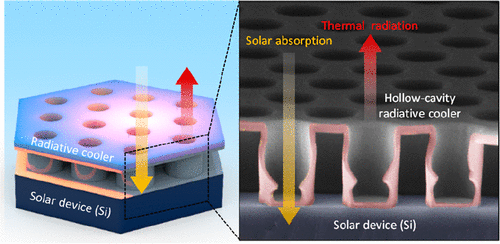当前位置:
X-MOL 学术
›
ACS Photonics
›
论文详情
Our official English website, www.x-mol.net, welcomes your feedback! (Note: you will need to create a separate account there.)
Scalable On-Chip Radiative Coolers for Concentrated Solar Energy Devices
ACS Photonics ( IF 7 ) Pub Date : 2020-09-12 , DOI: 10.1021/acsphotonics.0c00837 Jin-Woo Cho 1 , Sung-Jun Park 1 , Su-Jin Park 1 , Young-Bin Kim 1 , Ka-Youn Kim 2 , Dukkyu Bae 2 , Sun-Kyung Kim 1
ACS Photonics ( IF 7 ) Pub Date : 2020-09-12 , DOI: 10.1021/acsphotonics.0c00837 Jin-Woo Cho 1 , Sung-Jun Park 1 , Su-Jin Park 1 , Young-Bin Kim 1 , Ka-Youn Kim 2 , Dukkyu Bae 2 , Sun-Kyung Kim 1
Affiliation

|
Radiative coolers spectrally tailored at mid-infrared wavelengths (5–30 μm) achieve passive and efficient heat dissipation, thereby working together with existing conduction and convection channels. However, radiative coolers developed to date are structurally too complex to be scalable, too thick for monolithic integration, visibly opaque or reflective, or thermally unstable, particularly when integrated into optoelectronic devices. Here, we report wafer-scale, submicron-thick, on-chip radiative coolers designed for high-temperature concentrated solar energy devices. A hexagonally arranged SiO2/AlOx (500/300 nm) double-shell-covered array on a wafer exhibited an emissivity larger than 0.8 at omnidirectional incidence via optical-resonance coupled photon-tunneling effects, that is, uniform absorption distribution and reduced surface reflectivity. Daytime experiments showed that the double-shell hollow cavity film lowered the Si wafer temperature by 10 °C at one-sun intensity, concurrently boosting the Si absorptivity by 19% compared to a bare Si wafer. To reveal the feasibility of applying our developed film to concentrated solar energy devices, we performed concentrated solar simulator experiments at various illumination intensities up to twenty-sun. The radiative cooling performance became progressively significant by increasing the illumination intensity; at twenty-sun intensity, the hollow-cavity film yielded a 31 °C temperature drop when the Si wafer was heated at 200 °C. These economically viable, on-chip radiative coolers will help overcome the saturated quantum efficiencies of current optoelectronic devices that are fundamentally limited by thermal effects.
中文翻译:

用于集中式太阳能设备的可扩展片上辐射冷却器
光谱冷却器在光谱上适合中红外波长(5–30μm),可实现被动和有效的散热,从而与现有的传导和对流通道协同工作。然而,迄今为止开发的辐射冷却器在结构上太复杂而无法扩展,对于单片集成而言太厚,明显不透明或反射,或者热不稳定,特别是当集成到光电器件中时。在这里,我们报告了为高温聚光太阳能设备设计的晶圆级,亚微米级,片上辐射冷却器。六角形排列的SiO 2 / AlO x晶片上的(500/300 nm)双壳覆盖阵列通过光学共振耦合光子隧穿效应在全向入射时显示出大于0.8的发射率,即均匀的吸收分布和降低的表面反射率。白天的实验表明,双壳空心腔膜在一个太阳光下将Si晶片的温度降低了10°C,与裸Si晶片相比,Si的吸收率提高了19%。为了揭示将我们开发的薄膜应用于聚光太阳能设备的可行性,我们在高达20个太阳光的各种照明强度下进行了聚光太阳模拟器实验。通过增加照明强度,辐射冷却性能变得越来越重要。在二十太阳强度下 当将硅晶片加热到200°C时,中空膜的温度下降31°C。这些经济可行的片上辐射冷却器将有助于克服目前受热效应基本限制的光电器件的饱和量子效率。
更新日期:2020-10-21
中文翻译:

用于集中式太阳能设备的可扩展片上辐射冷却器
光谱冷却器在光谱上适合中红外波长(5–30μm),可实现被动和有效的散热,从而与现有的传导和对流通道协同工作。然而,迄今为止开发的辐射冷却器在结构上太复杂而无法扩展,对于单片集成而言太厚,明显不透明或反射,或者热不稳定,特别是当集成到光电器件中时。在这里,我们报告了为高温聚光太阳能设备设计的晶圆级,亚微米级,片上辐射冷却器。六角形排列的SiO 2 / AlO x晶片上的(500/300 nm)双壳覆盖阵列通过光学共振耦合光子隧穿效应在全向入射时显示出大于0.8的发射率,即均匀的吸收分布和降低的表面反射率。白天的实验表明,双壳空心腔膜在一个太阳光下将Si晶片的温度降低了10°C,与裸Si晶片相比,Si的吸收率提高了19%。为了揭示将我们开发的薄膜应用于聚光太阳能设备的可行性,我们在高达20个太阳光的各种照明强度下进行了聚光太阳模拟器实验。通过增加照明强度,辐射冷却性能变得越来越重要。在二十太阳强度下 当将硅晶片加热到200°C时,中空膜的温度下降31°C。这些经济可行的片上辐射冷却器将有助于克服目前受热效应基本限制的光电器件的饱和量子效率。



























 京公网安备 11010802027423号
京公网安备 11010802027423号